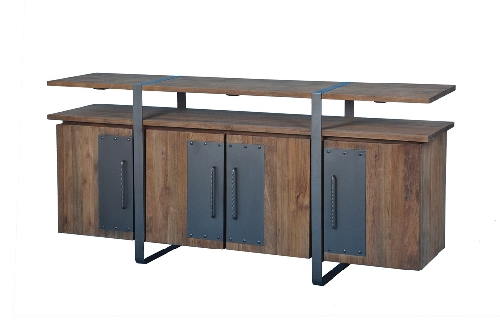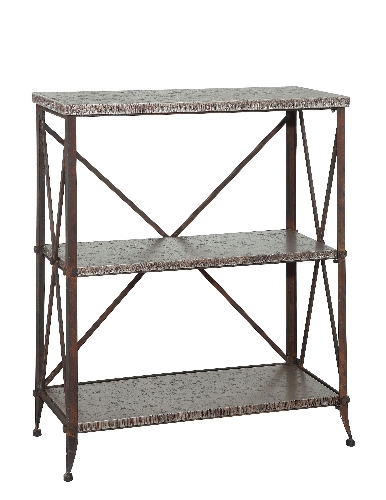Industrial (Furniture) Revolution
While our favorite electronics continue taking on ever slimmer and sleeker forms, some of the furnishings designed to house them are bulking up like never before.
Need a new media console for an ultrathin, high-tech television? Among your choices are hefty, raw wood cabinets with rugged steel accents. Furnishing a workspace to house a featherweight laptop or a shiny new iPad? Why not a laptop desk made of hand-hewn lumber supported by industrial workshop saw horses? And if you're drawn to the earthy look of thick, reclaimed wood for your bedroom, you won't have to give up contemporary features like built-in power strips for recharging your iPod and cellphone.
"More and more furniture manufacturers are joining the industrial furniture revolution," said Jackie Hirschhaut, vice president of the American Home Furnishings Alliance.
Dozens of showrooms at the High Point Market in North Carolina, as well as at the World Market Center Las Vegas, displayed furniture and home accents with an industrial look during their most recent trade shows for the industry.
"Designers are looking to vintage factory fixtures for inspiration and creating pieces -- even entire collections -- that bring elements of our industrial past into today's homes," Hirschhaut explained.
It's a casual contemporary look said to have originated in France and been popularized here by the California-based retailer Restoration Hardware.
"Its prevalence now, in everything from luxury brands to more mainstream furniture lines, is hard to explain, but it may have something to do with the interesting contrast it provides for our complex, technology-driven lifestyles," Hirschhaut said.
In its most rugged form, this trend takes reclaimed wood and old factory hardware and, with minimal restoration, fashions it into functional furnishings. From media consoles and cocktail tables to book shelves and laptop desks, these simple, utilitarian pieces add a touch of industrial chic to modern interiors. The use of recycled components also adds an eco-friendly element to these collections.
A good example of this look is the d-Bodhi collection, which debuted in the Four Hands showroom at the Las Vegas Design Center this summer.
Artisans from the European eco-friendly design house transformed rough nail-filled wood from old houses and boats, scrap iron from ships and even recycled denim into furnishings for homes, offices, retail shops and restaurants. Its five collections marry the edgy, urban look of galvanized steel with the warmth of reclaimed teak and recycled boat wood. Pieces have a European sensibility, yet do not have a stark modern look.
"d-Bodhi has always grabbed our attention with cutting edge design combined with some of the most impressive visual merchandising in the industry. They have a very dynamic design team and emphasize minimizing their eco-footprint," stated Matthew Briggs, chief executive officer and president of Four Hands.
In its more popularized form, the industrial trend is expressed in collections constructed using sandblasted or "raw" wood with varying degrees of distressing. Hardware and metal accents frequently have an industrial feel, and designs are often elemental or modular. Visible casters are popular additions to occasional tables and small storage pieces.
"These designs bring a unique point of view to any room," Hirschhaut pointed out. "And, with the wide range of introductions that reflect this trend, consumers who are shopping for this look later this year will find options to fit nearly any budget."
The industrial look fits hand-in-hand with the trend toward mixing materials in furniture, i.e., blending metal, wood, stone and glass.
Powell's new Foundry collection, for example, combines metal frames that have a hand-painted faux rust treatment with wooden tops that have been hand painted and hand carved. The industrial-inspired group of accent pieces puts cutting-edge contemporary design together with elements of turn-of-the-century assembly lines.
The Culver City, Calif.,-based manufacturer also pays homage to the iron age with its Quarry dining group. Wrought iron and faux marble are used in this traditional design.
Hali Bernstein Saylor, editor of Home: furniture and design, contributed to this article.
























